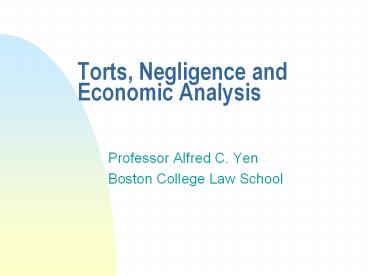Torts, Negligence and Economic Analysis - PowerPoint PPT Presentation
1 / 13
Title:
Torts, Negligence and Economic Analysis
Description:
How does the barge owner behave under negligence? How does the barge owner behave if he bears the loss, no matter what (strict liability) ... – PowerPoint PPT presentation
Number of Views:80
Avg rating:3.0/5.0
Title: Torts, Negligence and Economic Analysis
1
Torts, Negligence and Economic Analysis
- Professor Alfred C. Yen
- Boston College Law School
2
Question Does BltPL accurately identify the
person who is responsible for the costs of an
accident?
3
Hypo 1
- In the absence of precaution (bargee on board),
average of .5 accidents per year at cost of
40,000 per accident - Cost of bargee is 10,000 per year
- Is the barge owner negligent?
4
Answer 1
- Yes, hes negligent because
- B 10,000 (cost of bargee)
- P .5
- L40,000
- PxL20,000
- 10,000 lt 20,000, so B lt PxL
5
Hypo 2
- Is the tugboat operator negligent?
6
Answer 2
- Tugboat operator is negligent because
- B 10,001 (cost of bargee plus bribe)
- PxL 20,000
7
Question Does it matter if liability is based
on fault?
8
Thoughts
- How does the barge owner behave under negligence?
- How does the barge owner behave if he bears the
loss, no matter what (strict liability)? - How does the tugboat owner behave under
negligence? - How does he behave under strict liability?
9
Some observations
- BltPL doesnt resolve who is responsible. Both
parties appear negligent. - Determination of negligence doesnt change
ultimate result because precaution will be taken
regardless of the liability rule adopted. - When, if ever, does this line of thinking lead to
policy recommendation?
10
Examples of when it might matter
- Information inequality.
- Cost of bargain too large.
11
Policy recommendations depend greatly on market
structure one assumes
- If you think that markets are pretty good, then
the cheapest thing to do is let losses fall
where they do. - If you think that markets are significantly
flawed, then you place the obligation of
precaution on the person most able to make the
relevant calculation of risks and take
precautions. Examples manufacturer knows and
can do more about safety of product, landlord may
know more than tenant
12
More policy ideas
- Strict liability may be cheaper than negligence
because one need not litigate the issue of
liability. If (and its a big if) we can easily
identify the right person to hold liable, the
legal system has less to do. - This may join with the idea let the loss lie
where it falls. Victims always pay because
theyre easy to identify. Identifying the
cause is much harder.
13
Objections
- Distributional consequences go unconsidered, or
at least submerged to the cost idea. - Fault is a valuable concept. This whole line of
analysis eviscerates it. Unreasonable behavior
should have its consequences. - No just society arranges its affairs in relation
to money or its equivalent. - Unsupportable assumptions about human behavior
and the relative costs of accidents underly this
whole scheme. Can pain and suffering be measured
in money?































